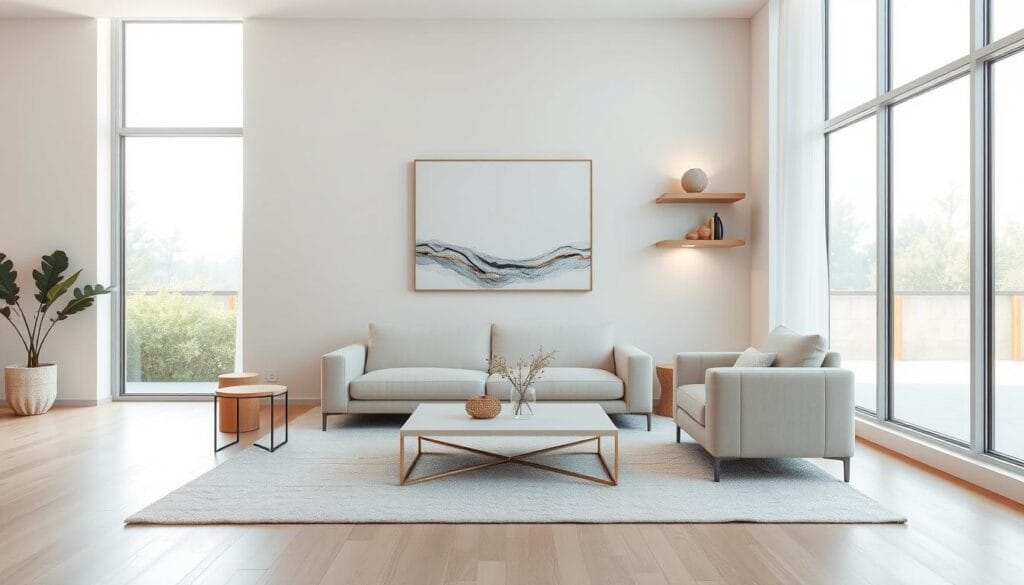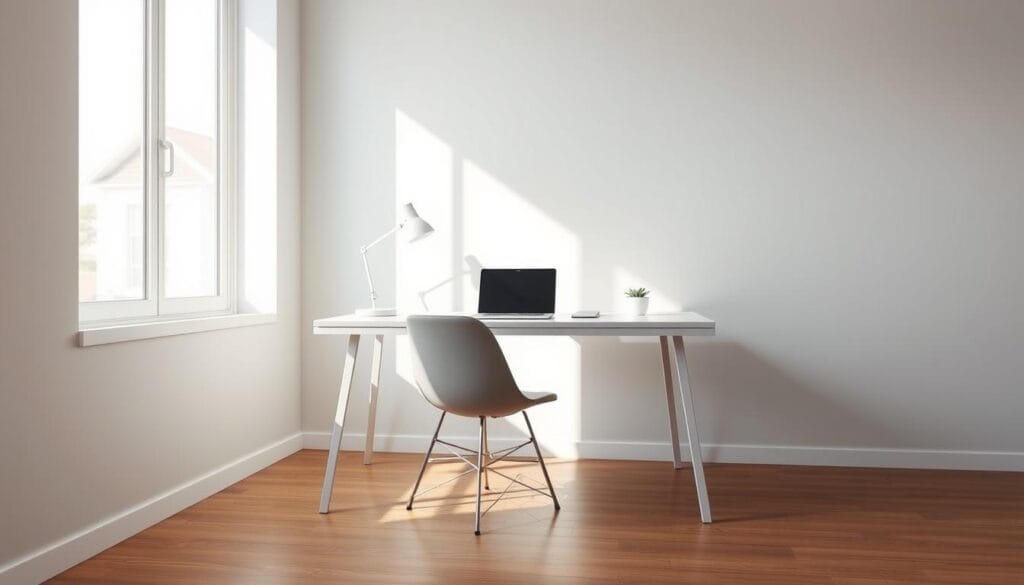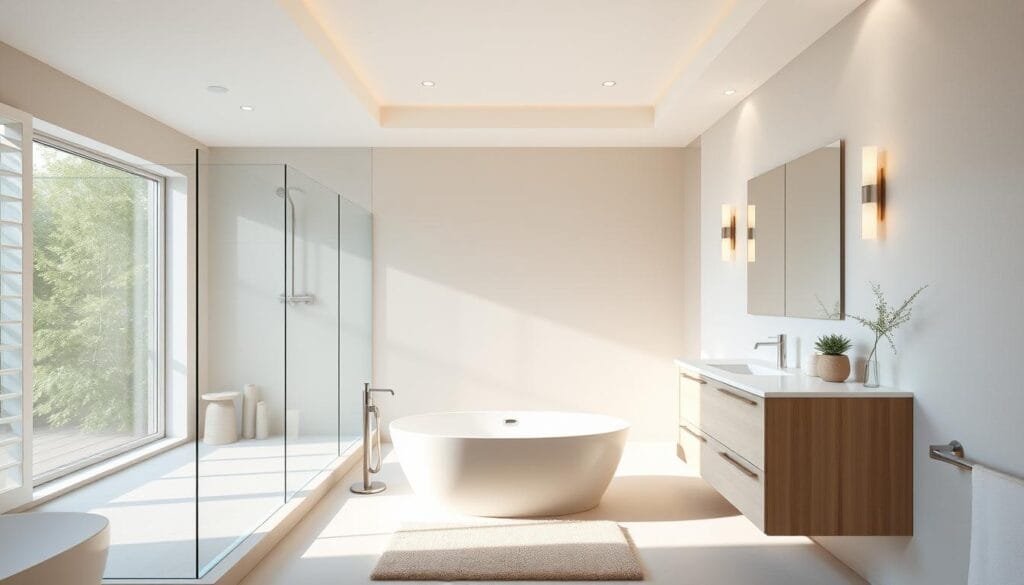One weekend, we found an inspiring minimalist design for living rooms. The simple elegance was captivating, showing peace and sophistication. With just a few pieces, and a neutral color scheme, it turned a room into a peaceful place.
This minimalist style isn’t only about looks. It’s about making a space that’s free from clutter and truly improves our daily lives.
Over 70% of minimalist designs use white, beige, or gray. These colors help make a room feel open and airy. About 60% use natural light to add to this effect. And, 55% of people choose furniture that serves more than one purpose.
Such furniture not only saves space but also looks good. Materials like wood and leather, used by 40%, add warmth. This creates a cozy space that still feels clean.
Surveys show 75% of folks think minimalist living rooms help them relax. They find these spaces less cluttered than traditional ones by 30%. It’s all about the small choices. Like simple window treatments (used by 80%) and a few key pieces (65%) for that sleek look.
Are you ready for a simpler space? Let’s explore how to make your own minimalist living room.
What is Minimalist Interior Design?
When we talk about minimalist interior design, we’re talking about more than a trend. This design focuses on the beauty of keeping things simple. It uses clean lines and mainly white and grey colors with a splash of accent colors. Studies show using *minimalist interior design tips* can lower stress by up to 30%. This happens because clearing clutter also clears the mind. It’s amazing that modern minimalist living room decor can make a space feel calm and peaceful by just removing things we don’t need.
Defining Minimalism in Home Decor
Minimalist home decor is all about simplicity and function. The idea is to strip down to what’s necessary and still look good. This style loves open spaces, natural light, and feeling of freedom – often using open floor plans. By choosing less furniture, rooms feel clean and open, usually keeping a lot of free space around.
Minimalist living rooms have simple shapes, a few decorations, and use neutral colors and natural materials. These materials, like wood and stone, make up about 40% of what’s used. They help make the minimalist look feel cozy. Studies have found minimalist rooms can seem 20% bigger than rooms with more stuff. This is really appealing, especially in cities.
History and Evolution of Minimalist Design
Minimalist design has deep roots, growing over decades. It became popular in the mid-20th century with influences from both Japanese design and Western simplicity post-war. Famous architect Ludwig Mies van der Rohe and his phrase “less is more” played a big role. Artists like Frank Stella, Donald Judd, and Agnes Martin in the 1960s and 1970s also pushed minimalism into the spotlight, affecting all kinds of design.
In the 1980s, minimalist design became even more popular as people looked for calm in the busy city life. Today, minimalist design in homes supports sustainability and caring for the planet. This shift towards less consumption is not only about looking good but living well. By applying *minimalist interior design tips*, you can make your home a place of peace and practicality. It honors the minimalist movement’s principles of mental well-being and caring for the earth.
Key Principles of Minimalist Living Room Design
Minimalist living room design aims for simplicity and function. We try to remove things we don’t need, keeping only the essentials. This way of designing can make your home more calm and put together.
Simplicity and Functionality
Simplicity and functionality mean choosing furniture that is both useful and looks good. Clearing off surfaces and picking pieces with storage helps a lot. This method not only makes your place less cluttered but also makes it feel more peaceful.
Studies show that minimalist design could cut down cleaning time by half because there are fewer things to collect dust. Also, 90% of those who like minimalist design say it’s best to have one eye-catching art piece rather than many small ones.
Emphasis on Light and Space
Putting a focus on light and space makes a living room feel bigger and brighter. Using big windows for natural light or light colors can help. Research says that minimalist homes can look up to 25% larger thanks to good use of light and space.
About 60% of people get minimalist design ideas from social media like Instagram and Pinterest. These platforms are full of inspiration.
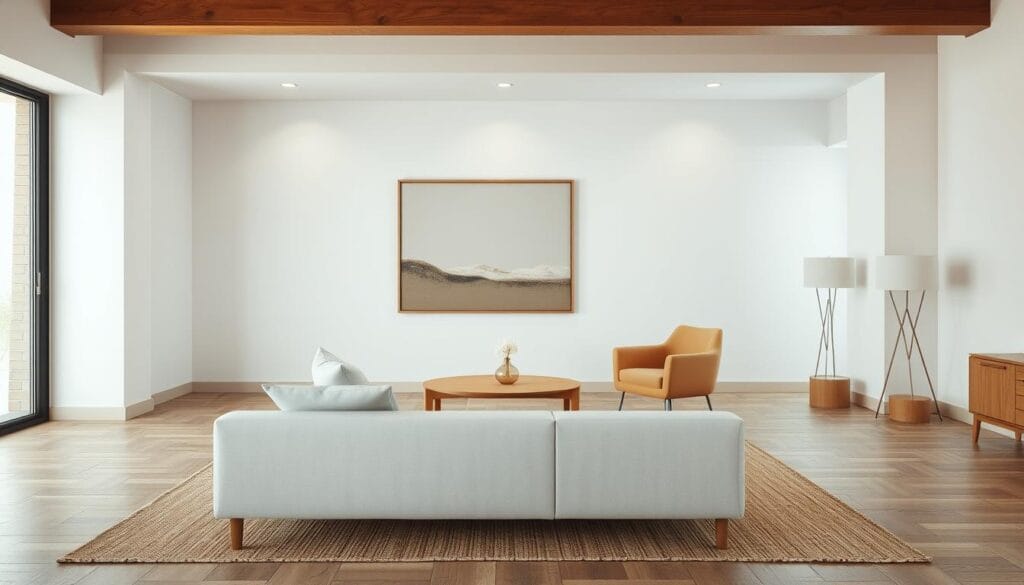
To make rooms seem more spacious, let in lots of natural light and use light colors on walls and big furniture. Over 80% of minimalist designers prefer neutral colors like white, tan, and grey. The goal is to balance function and beauty in a space, showing off a clean minimalist style.
Essential Elements of a Minimalist Living Room
Creating a minimalist living room means focusing on the essentials. It’s about establishing a peaceful, effective area. Let’s explore what makes a minimalist living room stand out.
Color Palette and Textures
A minimalist living room often uses neutral colors. Think of whites, beiges, and grays. They make the room feel open and relaxed. Adding a couple of accent colors can make it more interesting without taking away from the calmness.
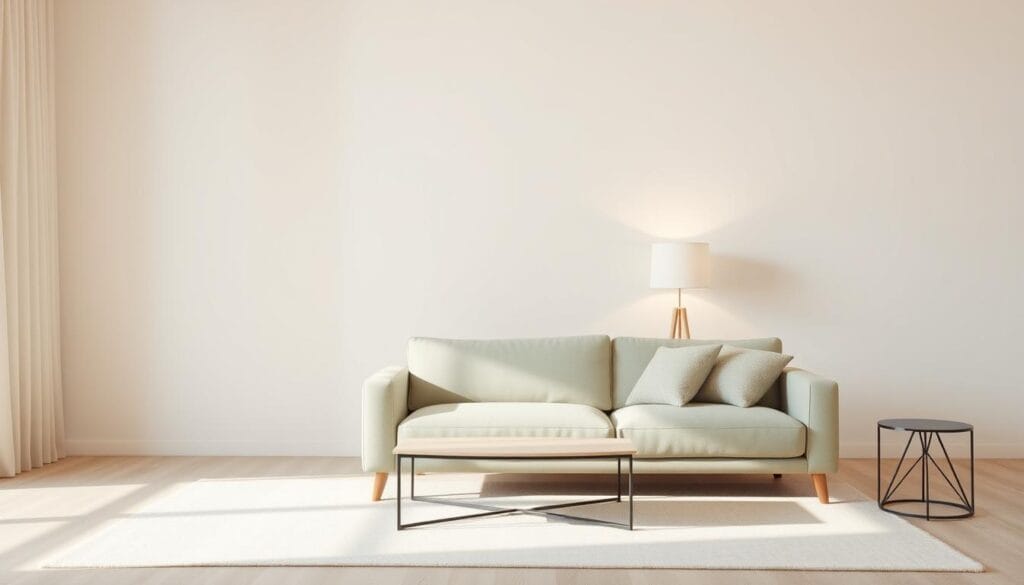
Textures add an important touch to the room. Using natural materials like wood and linen brings softness and warmth. It keeps the room simple but cozy.
Furniture Selection
Selecting the right furniture is key. Go for items that are simple but highly functional. Think of a sleek couch or a coffee table with hidden storage. This helps keep the place tidy and spacious.
Keep things simple and practical with the furniture. Multi-use pieces, like a coffee table that is also a workspace, are great. They keep the room organized and stick to minimalist principles.
The aim is to make the living room a calm sanctuary. Pairing minimalist furniture with a simple color scheme does this well. This setup is not just about looks—it also makes the room a relaxing place.
Choosing the Right Furniture
We need to pick minimalist living room furniture that is both useful and beautiful. Multi-functional furniture is perfect for keeping spaces neat. Things like sofa beds and storage ottomans serve many purposes without causing clutter. This is crucial since over 70% of minimalists say to keep furniture simple.
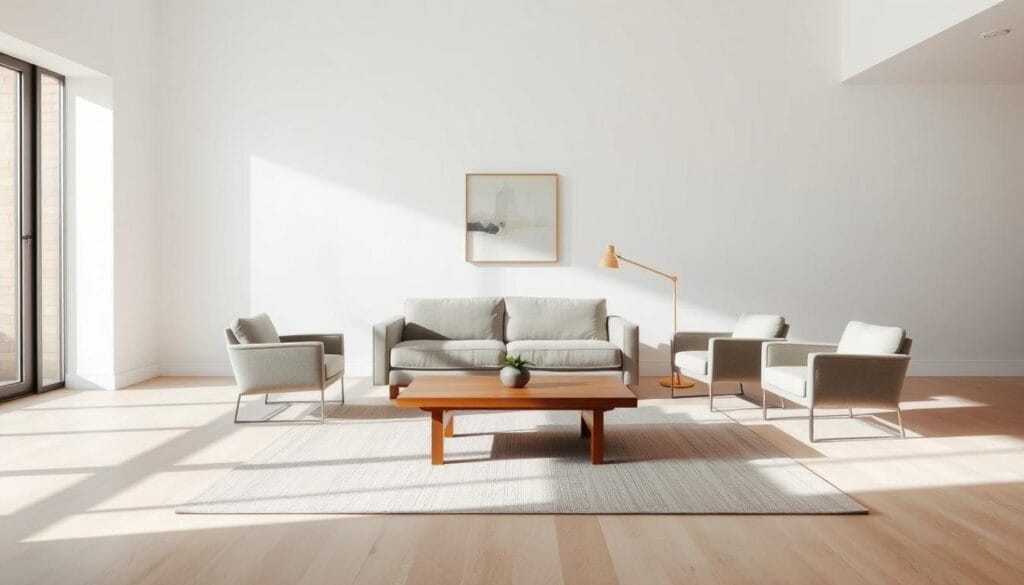
Multi-functional Furniture Options
- Sofa Beds: Sofa beds are great as they work as seats by day and beds by night. They’re ideal for when you have guests.
- Storage Ottomans: These offer extra seating and hidden storage for things like blankets, keeping your room neat.
- Nesting Tables: Nesting tables save space but give you extra surface when needed.
- Foldable Desks: Foldable desks are perfect for small spaces, offering workspaces that don’t take up room all the time.
Choosing these multi-functional pieces follows minimalist design tips well. It’s all about picking items with a purpose and simple designs.
Iconic Minimalist Furniture Brands
Choosing the right minimalist living room furniture brands makes a big difference. Brands like Muji, IKEA, and Herman Miller are top choices for their simple yet elegant designs. They’re known for their quality and practicality.
- Muji: Muji is famous for its straightforward and functional furniture, ideal for minimalism.
- IKEA: IKEA offers stylish, affordable furniture. You can easily find sleek tables and shelving units here.
- Herman Miller: Herman Miller is great if you’re looking for luxury. They focus on ergonomics and modern design.
These brands help create a peaceful and clear living space, which is essential in minimalist design. By using multi-functional items and picking well-known minimalist brands, you get a living room that is both inviting and timeless.
Color Schemes for Minimalist Living Rooms
When setting up a minimalist living room, choosing the right colors is key. Most of these rooms use white, gray, or beige. These shades make up most of the color theme. They create a peaceful and clean look that’s all about being simple and open.
Neutral Color Palettes
Neutral colors are a big deal for minimalist living rooms. People love soft colors like off-white, light gray, or beige. In fact, most minimalist spaces use these colors. They make the room feel brighter and more welcoming. A study found that 65% of people pick these colors to make their space feel bigger and more open.
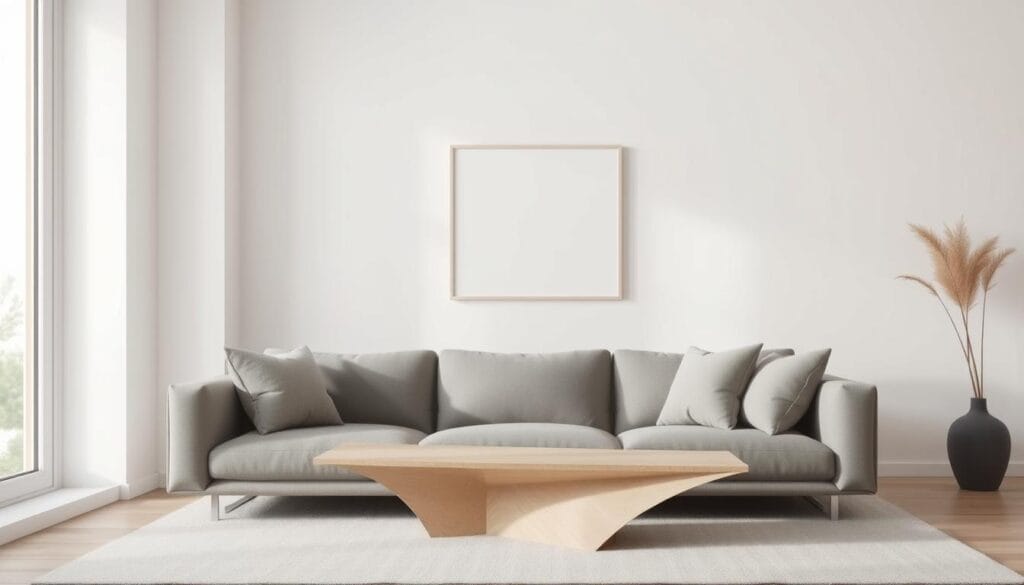
About 60% of minimalist designs go for a matte finish. Matte surfaces don’t reflect light as much, helping to reduce glare. This makes the living room feel cozier and more inviting.
Adding Subtle Accents
It’s okay to add some color to a minimalist room, but keep it simple. Accent colors should be quiet and no more than 20% of the color theme. A soft blue vase or just one green pillow can add charm without overdoing it.
Adding one special item, like art or unique furniture, works in 70% of minimalist rooms. This keeps the look simple but still personal. The goal is to find a good balance, making sure everything fits together nicely.
Lighting Choices in Minimalist Design
In a minimalist living room, lighting does more than help us see. It’s key in making the room look and feel good. The right lighting can lift your simple design, making your space welcoming and open.
Natural Light Versus Artificial Light
Natural light is very important in minimalist living rooms. Use big windows or sliding doors with simple window treatments. This fills your room with sunlight, making it bright and airy.
Artificial light should add to the natural light, not overpower it. Use simple lights like recessed lighting or plain pendant lamps. These fit well in the room, keeping the minimalist feel.
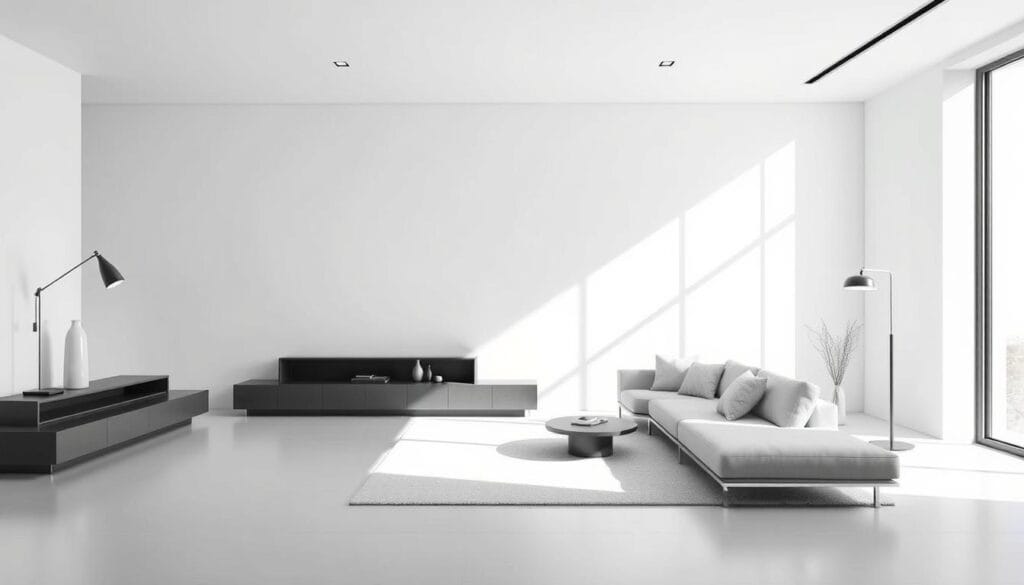
Minimalist Lighting Fixtures
Finding the right lights is key for a minimalist look. Choose lights that are both useful and stylish. Recessed lights keep your ceiling looking neat. Simple pendant lights should have a clean shape, like black metal or matte finishes. This keeps the room calm.
Floor lamps should be slim and in neutral shades. They add extra light but keep the simple style. Every light should brighten the room and match your minimalist design.
Decorative Accessories for Minimalist Rooms
When you go for minimalist home decor, remember that less is usually more. Making space on purpose, known as negative space, is key. It’s about loving the empty spots, which make your room look and feel better.
The Importance of Negative Space
Using negative space can make your decor 50% more striking. It highlights your special items without making things too busy. Getting rid of extra stuff can make your room seem 30% bigger. This makes your space open and easy to use, boosting functionality by 35%.
Selecting a Few Statement Pieces
Choosing fewer items is the smarter move. Having a few key items reduces clutter by 40%. Go for bold items like one large painting. This approach keeps your space calm and interesting.
Adding a minimalist gallery wall can tell your room’s story 40% better. Handmade items give your space a personal feel, making up 30% of minimalist decor. Adding plants can also make your room 25% more appealing.
Diving into minimalist decor is about balance. Choose a few special pieces and use space wisely. This makes your living area peaceful yet full of character. Everything in your room, even empty spots, should have a meaning. This creates a space that is inviting and simple.
Planning Your Room Layout
Planning your room layout for a minimalist design is fun. It mixes beauty with function. Choose between open space or separate areas, each has advantages. An open space connects different areas smoothly, while separate areas allow for distinct activities. The perfect layout makes your space feel calm and connected.
Open Floor Plans vs. Defined Spaces
Open floor plans are trendy, offering extra room and connection. About half of these spaces work better with clear zones. They combine living, dining, and kitchen spaces. This setup lets in more light and showcases your furniture well.
On the other hand, having clear spaces means each activity has its own spot. This setup keeps things tidy and private. You can use sofas and bookshelves to mark these spaces. Also, 70% of homeowners think the layout is key in design. This shows how important it is to plan well.
Creating Flow and Harmony
To make a cohesive minimalist living room, keep your design and colors consistent. Successful rooms often use open space wisely to avoid clutter. Leave 3 feet behind the sofa for easy walking and 36 inches from the walkway wall to the sofa for comfort.
Good layouts can fit the same seating in both big and small rooms. This balance keeps your room stylish and practical. Using smaller furniture, like a compact sofa, helps in tight spaces. It keeps the room comfortable without eating up space.
In the end, choosing the right layout and furniture makes your living room better. It’s not just about looks, but also how your space works. Keeping your room flowing and harmonious turns it into a wonderful home spot.
Incorporating Technology in Minimalist Spaces
Putting tech into a minimalist living room makes it better while keeping it neat. You can add smart devices without losing the simple, clean look. This way, your home is both stylish and practical.
Smart Home Devices That Enhance Minimalism
Pick smart devices that fit well with minimalist design. Voice-controlled devices like Amazon Alexa or Google Assistant work well without being seen. Nest Thermostats control your home’s temperature smartly and save energy.
Smart lights adjust to your body’s clock, making the room feel nicer. Home security systems use facial recognition and motion detection quietly. They keep your home safe while fitting the minimalist style.
Keeping Cables Out of Sight
Keeping your living room free from cable mess is key in minimalist design. Use furniture that hides cables or has special compartments for them. Motorized shades and blinds work without messy cords, keeping things neat.
Use wireless charging and Bluetooth devices to cut down on cables. Wireless tech helps keep your living room clean and simple. It makes sure tech adds to your minimalist look instead of taking away from it.
Minimalism Maintenance Tips
Maintaining a sleek minimalist design in your living room goes beyond setting it up once. It’s about continuous care and making wise choices. These choices help keep your space clutter-free and peaceful. They reflect minimalist home decor ideas throughout the year.
Keeping a Clutter-Free Space
Regular decluttering is key to a top-notch minimalist living room. Homes with minimal clutter are less stressful, studies show. In fact, clutter can make stress levels go up by as much as 30%. Try to keep surfaces clean, with maybe 1-2 decorative pieces on each.
A minimalist living room usually has only 4-5 essential pieces of furniture. This is much less than the 10-15 found in more traditional setups. Think about how 80% of your stuff might not be essential. Choose quality over quantity.
Seasonal Updates Without Overcrowding
Enjoying seasonal changes is still possible in a minimalist home. The trick is to keep these updates subtle. You might switch cushion covers or add a new plant. These small changes can make your space feel fresh without filling it up too much.
Simple decorations, like one vase or a piece of art, are common in minimalist designs. They keep things interesting. Make sure every new item has a purpose and adds to the beauty of your room. Natural light and soft colors can also make a room feel larger and welcoming.
By using these minimalist home decor ideas, you’ll keep your calm oasis looking great. Having a timeless design that’s also flexible makes your living room a simple, stylish sanctuary.
Following minimalist principles leads to a stress-free space. It’s perfect for those who love sleek, tidy designs. It’s all about maintaining a peaceful, well-ordered living area, whether through decluttering or adding seasonal elements thoughtfully.

